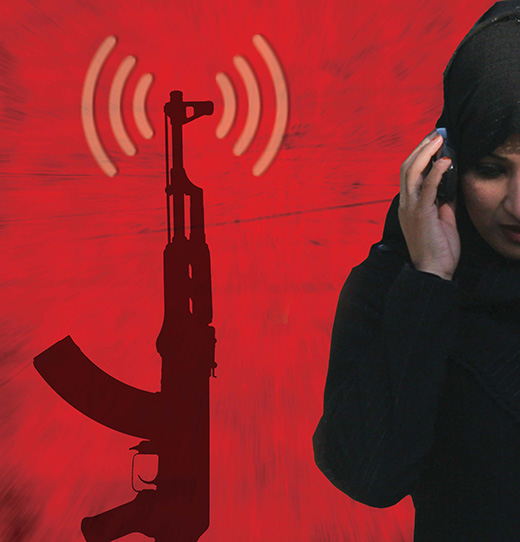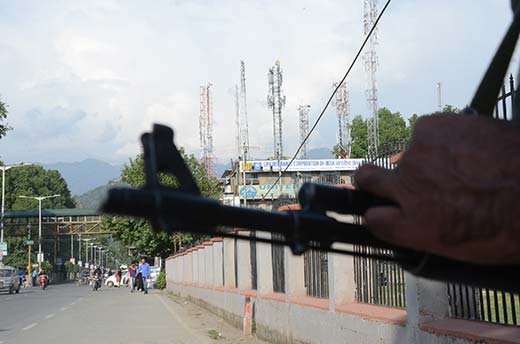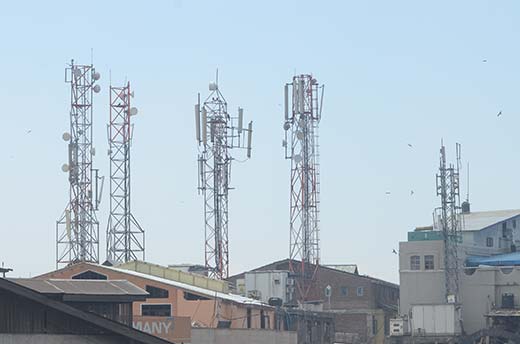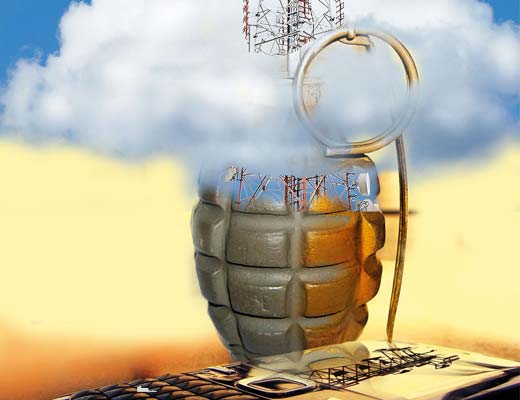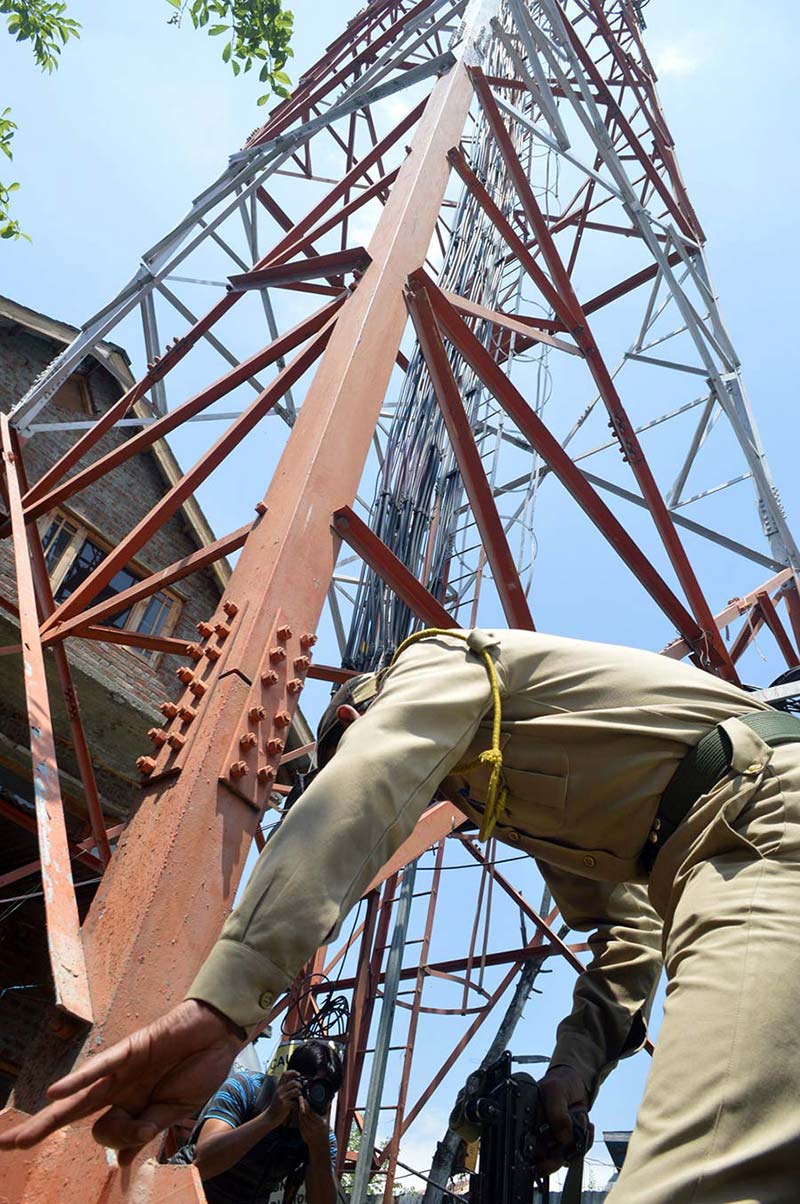Momentary disruptions in mobile services triggered a lot of heat and dust as it could hit J&K’s two-third population directly. Apart from impacting security situation over the year, this infrastructure sustained businesses and services and created Rs 2000 crore direct economy and a few thousand jobs. R S Gull offers the flip side of a technology that holds key to future, progress and some controversies
Weeks after 9/11, American broadcaster CBS premiered a sci-fi crime drama Person of Interest. An instant hit, it is entering fifth season later this year. Created by Jonathan Nolan, the drama revolves round the ‘machine’ that a techie created post 9/11 to prevent terrorist attacks. A powerful surveillance system, the ‘machine’ analyzes every individual’s digital footprints – telephone conversations, travel, social security details, bank transactions, backgrounds, official records, and live images from roadside surveillance cameras to indicate what they are heading towards. National security apart, the ‘machine’ has the capacity to identify persons in distress and indicate possible crimes in anticipation.
The ‘machine’ is in control of the government but its builder has retained the code. The government uses it to prevent terrorist violence, its billionaire builder, creates his own group to tackle the crimes, illegally. Person of Interest is the case of an infrastructure being used by two different forces for two different purposes. That is precisely what might be happening to the Base Transceiver Stations (BTS), the main infrastructure for mobile telephony, in Kashmir. Owned by various telephone companies, security agencies have used this facility in counter-insurgency and the outlaws are now accused of using the same facility to communicate with each other! This led to a brief panicky showdown and, if escalated, could have proved costly to Kashmir.
An action that affects 8331381 people in a single go is a real mess for any society.
It started almost innocuously. A BTS caretaker in Sopore traced something attached to the tower and removed it. A day later, a group of youth, apparently militants started enquiring about “their equipment”. As their threat triggered panic, police got involved in it. A few days later, cops actually recovered the ‘equipment’. “It was a Kenwood radio set that was fixed to the tower,” a senior police officer said. “Its placement at a height was improving the range of the militants’ communication set-up in the area.”
By May 24, DIG North Kashmir Gareeb Das was in a press conference claiming the recovery of the “device” and asserting they are still investigating. He refused any knowledge about the shadowy outfit Lashkar-e-Islam, that had allegedly issued threats, distributed posters against the mobile set up and even raided various telecom company offices in the area. This, however, marked beginning of the start of the “crisis”.
By then suspected militants had beat many people associated with mobile business and even lobbed a grenade towards a BTS. Post Dass presser, they started hitting. On May 25, less than 15 hours after the news conference, they barged into Iqra Telecommunications and Electronics in Sopore’s crowded Shah Faisal market and opened fire. Rafiq Akbar Hanji of a Handwara village was killed and two others Ghulam Mohammad Bhat, the shop-owner, and Imtiyaz Ahmad Lone were injured. They are still in the hospital.
Next day on May 26, militants made a surprise raid on the residence of Ghulam Hassan Dar in Dooru village, in town’s outskirts. They fired 22 rounds on him and killed him almost instantly. Dar was taking care of the BTS that Airtel had raised in his premises. Two murders were enough to create scare and one after another towers were switched off by terrified caretakers. A grenade throw on a tower in Srinagar (June, 1, 2015) added to the mess in the city.
“Our 30% network was affected and now it is gradually improving,” a top BSNL executive said. “We are doing whatever possible to restore the service.” BSNL that has not been divulging its market since September 2012 across India, claims it has around 8.5 lakh subscribers in J&K. Counting along with Airtel’s 3036173, Aircel’s 2677070, Vodafone’s 1235738 and Ideas 532400 registered users in the state, J&K is 66.65% population is using mobile telephone.
An action that affects 8331381 people in a single go is a real mess for any society.
But cell phone’s entry into Kashmir has remained bumpy. Security grid was apparently very upset over the government insisting that J&K cannot stay away from the technology loop at a time when mobile is changing socio-economic profile of people across the world. Almost instantly after introduction, there was an anti-climax when a DIG rank officer in a paramilitary force was recorded threatening a scribe!
But the security grid invested massively in retaining its pie in the new economy. Apart from creating an elaborate surveillance system at Srinagar and Jammu, there are impressive set-ups even at district levels. The cop knows who is talking what and where he or she is heading. It all depends whether or not the cops avail the option of using the technology that is just a finger-tip away. While the executive police usually seeks formal permissions from competent authority to listen to specific numbers, those in the operational field enjoy sort of flexibility, albeit not under law. Law enforcing agencies seek call detail records from the telecom operators if and when they need. This is in addition to a “good number” of people, mostly separatists of all sorts, whose phones are usually under surveillance.
Almost coinciding with the entry of mobile phone, security agencies started introducing SIM cards in the insurgent ranks, their sympathizers and relatives. This operation had such a depth that some of the SIMs that militants used in Mumbai attack were found to gone from J&K. A cop was arrested as well, but walked free, because he was operating under cover. Insiders in the security set up say this practice was responsible for some of the major successful operations against militants.
“It was an unending source of information about location, contacts, even number of accomplices and sometimes even timing of possible attacks,” one police officer talking anonymously, said. “One day, a militant changed his location and threw his SIM away after learning that it belonged to us. When he reached another hideout; I rang him up and told him that even this SIM belongs to me. He was shocked and in frustration, he threatened to attack but I pulverized him by telling him that he lacks capacity as he is carrying just a grenade. He finally surrendered and survived.”
Within years, the SIM card emerged as the most potent tool in a cops’ armory. In September 2006, cops tracked a BSNL SIM in Chanderkote having international dialing facility. A simple investigation led to neutralization of all the Hizb ul Mujahideen militants who were in touch with this SIM.
Later in December, cops investigating an attempted murder in Chak-e-Kawoosa detected a group of teenagers on their radar – some of them still in school and college. Investigations suggested they were gifted a SIM card each by a militant and the gang of eight had emerged as a module of “contract killers” who had settled four murders for Rs 32,000 each!
In February 2007, a civilian handed over a SIM card to a top police officer in Baramulla and this eventually led to a series of arrests who were offering detailed information to a top outlaw from the region.
Perhaps the most interesting instance involving cell phone and insurgency took place on January 9, 2006 when Special Operations Group (SOG) attacked a Harkat top man who fled Pulwama leaving behind his cell phone. A chase led to his killing in Shopian on January 17 in the house of a Congress councilor. From there, cops recovered another cell phone, handled by councilor’s sister. This exposed the entire ring as a result of which police acted against its two cops. Their own cops had alerted the top militant as many as 25 times and saved him!
Surveillance of just one SIM card in August 2006 helped police unveil the assassination attempts on Mufti Sayeed involving some of the elected councilors and the militants.
A cut throat competition between different counter-insurgency players in managing more successes created a situation that they would eves-drop each other. An officer in SOG when posted in a peripheral district said he was surprised to see that his predecessor had put his phone on surveillance just to know if I am getting into his territory!
Insurgents started with huge sophistication in their communication. Between 1989 and 2000, especially during the early years, militants had a set up in place that they would claim an attack within moments of the happening. The armed forces, however, had the traditional system envisaging information moving from battalion to headquarters and eventually to their PR cells and finally to media. On various occasions, the army would refuse confirming particular incidents the same day but would confirm it the other day.
By the time, security grid improved its network and the system of dissemination; outlaws were already on the satellite phone networks. It was demonstrated during the al-Faran days. But the introduction of cell phone was alluring to all, especially militants. Later militants started securing SIM cards on fake identifies, usually in the Hindu names and so called soldiers and policemen. Within days, they started using SIM cards to detonate landmines which added to the pressures on industry and the security grid.
Militants and security men apart, everybody was enjoying the little new wonder. State Police intelligence that uses telephone as a source of information, historically, would drop a CD at the then Chief Minister Ghulam Nabi Azad’s residence and the Chief Minister would come to the assembly and tell lawmakers about his “shock” over what he listens about “which way our new generation is going”. It stopped finally when some of his well meaning friends advised him to skip listening to CD as “it distracts you from governance”. The process, however, was restarted during the 2009 when Shopian was boiling over the two female deaths.
“There might have been various pulls and pressures that led to the collapse of the strike in Shopian,” one policeman who was in know of things despite that he was not deployed in Shopian in 2009, says. “It was just a cell phone that one day fetched cutting edge intelligence about one person and that marked undoing the agitation.” The person was summoned and told that his conversation could go live!
By then Cyber Police Stations were in place both at Srinagar and Jammu. In 2010 when the civilian unrest was at its peak, cell phone was fundamental source of information: the government was looking for every input that would help it know who is advising Delhi and what is the line that Manmohan Singh government is taking on taking Omar government.
This was not the first time that phone had come handy. Even in 2002, soon after PDP became No 2 seat-holder in assembly and there was no mobile, the traditional phone was still the leader. Then, Haji Yousuf, the same fixer who died in police custody, was with Hakim Yasin telling somebody in the NC that “after this night, it is over”. Sleuths sniffed this line and during the same night Haji was “invited” for a meeting and within an hour he spilled the beans about how Mufti’s government was being toppled. Next morning he was talking to many people in PDP including the Chief Minister asserting “it was just nothing”.
As the biggies and mighty in the situation were playing their games, cell phone gradually entered into the DNA of state’s society and economy. Gradually it emerged into a major economy itself. The fact is that people are literally spending more on telephone than the energy, a sector that is plaguing the public finances of the state. In 2014 (see table), the earnings that various cell phone providers collected from J&K was a record high of 1450 crore!
Right now, the mobile users in the state are carrying sets worth Rs 6500 crore in their hands. Every year new mobile sets worth Rs 600 crore are sold.
Coupled with internet – that was withdrawn twice since its introduction by BSNL, cell phone has changed the market completely. “I do not travel to Srinagar or Jammu,” Ghulam Mohammad, a general merchant having interests in many sectors, says in Banihal. “I send the photo of the specimen I require on whatsapp and the supplier sends it by transport.”
“How do you think, I can survive without this phone,” says Ghulam Hassan in Sopore. “My kids require this phone for filing admission form and downloading their results and submitting their fees. I do not want to go back to the old days when I used to travel for hours to reach Srinagar.”
As people are enjoying the technology, they least know that any development in any conflict area has the flip side too. Though the satellites and big players like Google have busted the visible physical secrets that states were holding, India, Pakistan and China still have to take care of their defenses and interests. BTS is one key infrastructure that has the capacity to inter-connect political geographies. Mobile players say they have taken adequate measures to ensure that people from across do not use this, but technologies upgrade more often than users think. It is still a fragile system. Preventing signals from each other’s territory entering their networks has remained the state position of India and Pakistan for a long time. But what has never been told is that efforts are to ensure one-way traffic at least. In anticipation of the Sopore episode, there were reports of creating additional infrastructure near borders in J&K to jam use of Pakistani SIM cards! These efforts will continue as they never stopped.
But on the militant front, the latest that insiders could share with Kashmir Life is that not-more-than 150 surviving militants are in disarray and completely disorganized, not carrying many weapons and they no more use cell phone. They may have radio sets but they rarely use it. “They use internet, precisely the Voice over Internet Protocol,” one officer said. “They use a particular application and once we try to get into it, they abandon it and move to another level and the chase continues.”
But the tech-wars are unstoppable. While the government would ensure it leaves no application unused if it enables state to tackle the outlaws, the process to make all the citizenry on board is already underway. It may take longer time than anticipated, the Aadhar No could well become the social security number in Jonathan thriller. Wait and watch.


